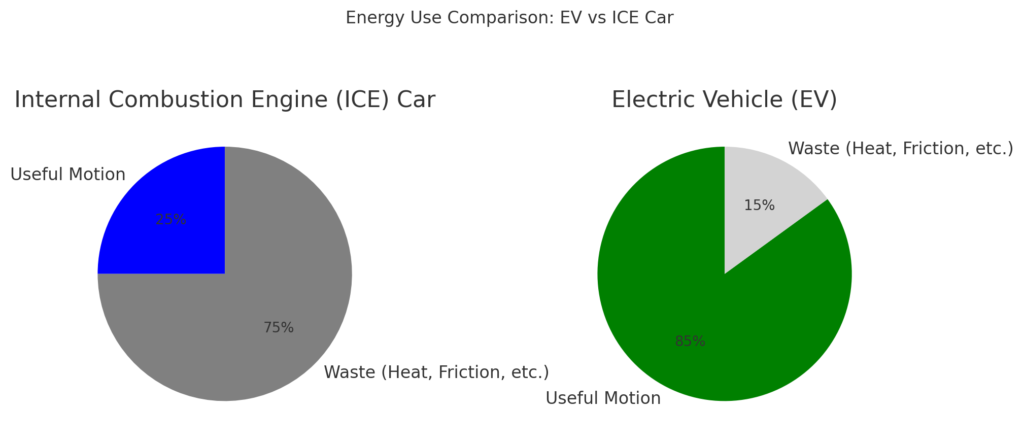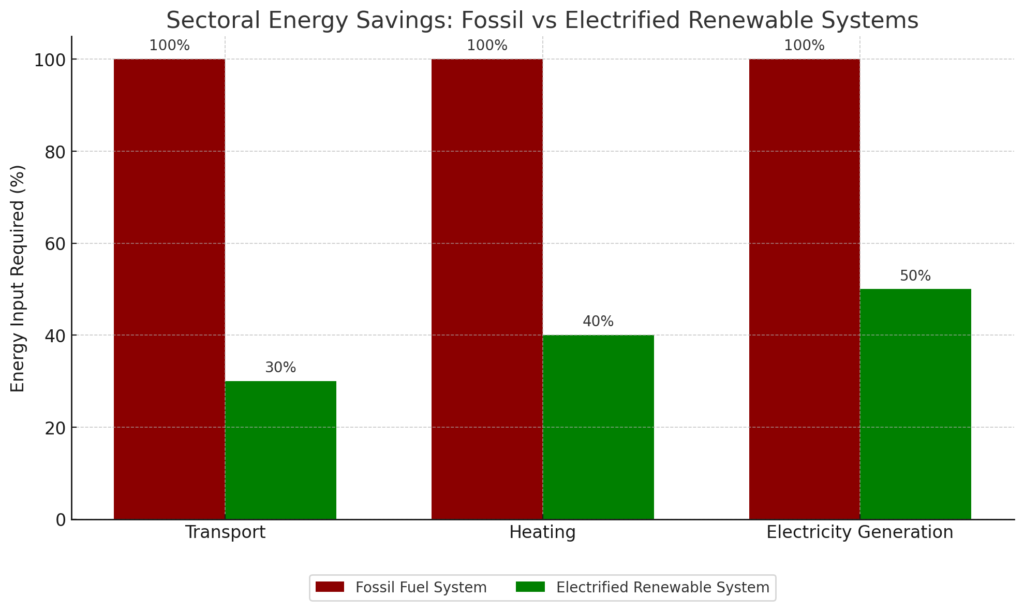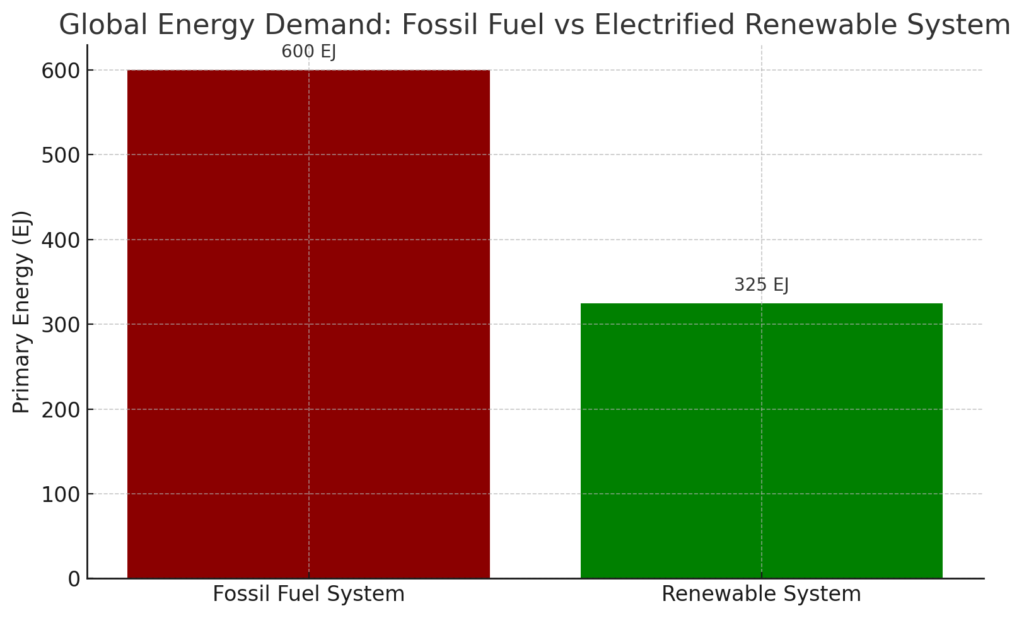In debates about the global energy transition, one misleading concept shows up time and time again: the “primary energy fallacy.” It’s a statistical illusion that dramatically exaggerates how much renewable energy we need to replace fossil fuels. Let’s unpack what it is, why it’s wrong, and why understanding it is critical to accelerating the shift toward a cleaner, more efficient energy future.
What Is Primary Energy?
Primary energy refers to the raw energy sources used before any conversion—like crude oil, coal, or natural gas before they’re burned. Traditional energy accounting treats all sources equally in terms of their energy content, regardless of how much useful energy they actually deliver.
For fossil fuels, this includes a significant amount of energy that is never used—it’s lost as waste heat during combustion. When we burn coal or gas to make electricity, or gasoline in a car engine, we lose most of that energy to heat. Yet, in primary energy statistics, it’s all counted.

The Fallacy in Action
Here’s where the fallacy kicks in: when people see that the world consumes around 600 exajoules (EJ) of primary energy annually—mostly from fossil fuels—they assume we’ll need 600 EJ of renewables to replace it. But that assumption ignores a key reality:
Fossil fuel-based systems are highly inefficient. Renewables and electrification are vastly more efficient.
Consider electric vehicles (EVs), which use 75–90% of their energy for motion, compared to just 20–30% in internal combustion engine vehicles. Heat pumps, similarly, provide 2–4 times more useful heat than the electricity they consume—far more efficient than gas boilers.
To make this more tangible, imagine filling two buckets with energy—one for an EV, one for a gasoline car. The EV bucket only needs to be filled a third of the way to go the same distance. The gasoline bucket, on the other hand, must be filled to the brim—and then two-thirds of it is thrown away as waste heat.
A 2022 study by LUT University found that switching to a 100% renewable, electrified global energy system would reduce total primary energy demand by nearly half. Reports by IRENA and the National Renewable Energy Laboratory (NREL) support similar conclusions: electrification shrinks demand.

How Much Less Energy Will We Need?
Thanks to efficiency gains, a fully electrified, renewables-based energy system would require 40–50% less energy than today’s fossil-based system:
- Transport: Energy demand drops by ~70% with EVs
- Heating: Reductions of ~60% using heat pumps
- Power generation: Avoids thermal losses (often 50%+)
600 EJ is roughly the energy needed to power every home on Earth for more than 15 years. With renewables and electrification, we could meet the same global services with just 300–350 EJ.

Why This Fallacy Persists
Energy statistics from the IEA, BP, and national governments still use outdated primary energy metrics that make renewables look smaller than they are. Some lobbying groups perpetuate this framing, emphasizing challenges of scale and reliability—often without recognizing the full benefits of electrification.
A Clearer View of the Future
Understanding the primary energy fallacy reframes the energy transition as not just possible, but practical and scalable. Yes, scaling renewables involves challenges: storage, transmission, land use, and mineral extraction for batteries. But these are engineering challenges, not existential barriers.
Already, progress is being made:
- Battery technology costs have dropped over 80% in a decade
- Recycling programs like Redwood Materials are scaling up lithium and rare earth recovery
- Agri-voltaics and offshore wind are reducing land-use pressure
Critics often raise concerns about intermittency, but smart grids, flexible demand, and diversified generation are steadily addressing them. For example, Denmark has achieved over 50% wind power penetration while maintaining grid stability.
Call to Action
To accelerate the transition, we must modernize how we talk about energy. Policymakers should adopt metrics that measure useful energy, not just raw input. You can help:
- Support EV rebates, building electrification programs, and local storage incentives
- Join energy literacy campaigns that challenge outdated narratives and educate others
If this article helped clarify the issue, share it with your network. The more people understand this fallacy, the faster we move toward a cleaner, more efficient future for all.
Bonus Perspective: Global Examples of Clean Energy Communities
🏘️ Feldheim, Germany — Entirely energy self-sufficient, powered by local wind, solar, and biogas with its own microgrid and storage. Lower energy costs, full local control.
🌬️ Samsø, Denmark — A pioneer in community-driven wind and biomass energy, this island produces more renewable electricity than it consumes.
⚡ Wildpoldsried, Germany — Generates 500% of its electricity needs through solar, wind, and biogas, selling the surplus back to the grid.
☀️ Adjuntas, Puerto Rico — A solar-powered microgrid allows energy independence in the face of climate disasters.
🌊 Schoonschip, Netherlands — A floating urban village running on solar with a smart sharing grid and battery storage.
These communities prove that clean, decentralized, efficient energy systems are not just possible—they’re thriving around the world.
Conclusion
While it’s true that electrifying everything—from transport to heating to data centers—will increase our electricity demand, it’s just as crucial to understand the efficiency equation. Replacing combustion engines, gas turbines, and other thermal machines with electric alternatives means slashing waste. We’re not powering the same system—we’re building a fundamentally leaner one.
The energy transition isn’t about doing the same things with different fuels—it’s about doing things smarter. By cutting waste and maximizing efficiency, electrification allows us to deliver the same energy services with far less input. The “primary energy fallacy” clouds this truth, making the transition appear harder than it really is. But once we see through the illusion, the path forward becomes not only clearer—but shorter, cheaper, and entirely achievable.
Credits & Further Reading
This blog builds on the more technical explanation by Sam Hamels and reinforces the concept of the Primary Energy Fallacy—a term originally coined by Michael Liebreich. By combining rigorous insight with practical framing, we can make this misunderstood issue more accessible—and help fast-track the clean energy transition.

